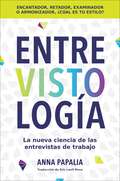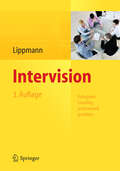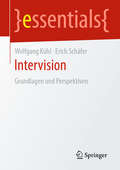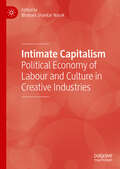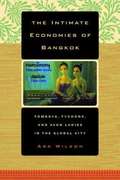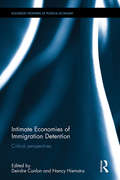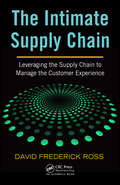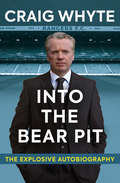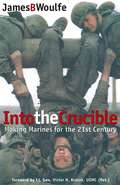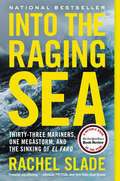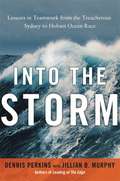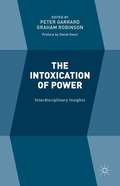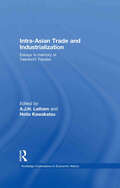- Table View
- List View
Interviewing: Principles and Practices
by Charles J. Stewart William B. CashInterviewing: Principles and Practices, the most widely used text for the interviewing course, continues to reflect the growing sophistication with which interviewing is being approached, incorporating the ever-expanding body of research in all types of interview settings, recent communication theory, and the importance of equal opportunity laws on interviewing practices. <p><p> It provides the most thorough treatment of the basics of interviewing, including the complex interpersonal communication process, types and uses of questions, and the structuring of interviews from opening to closing. <p><p> The Connect course for this offering includes SmartBook, an adaptive reading and study experience which guides students to master, recall, and apply key concepts while providing automatically-graded assessments.
Interviewing Rape Victims: Practice and Policy Issues in an International Context
by Karen RichThis study presents a unique overview of the cultural, social and practical aspects of interviewing rape victims. Exploring a range of issues that affect rape cases including discourse, gender, attitudes and victim's rights, Rich reveals the complexities of sexual assault and looks to how communities can work to respond to and combat such violence.
Interviewology: The New Science of Interviewing
by Anna Papalia“A must-read for seasoned and new managers alike.” —Johnny C. Taylor Jr., SHRM-SCP, CEO of the Society for Human Resource Management (SHRM)A groundbreaking guide to mastering the job interview, offering proven advice and techniques to discover your unique interview style that is key to interviewing better—for those on either side of the table.Conventional interviewing advice doesn’t work. That’s what Anna Papalia learned through years of experience as an HR professional, consultant for Fortune 500 companies, and teacher at the Fox School of Business. None of the existing tools work for one simple reason: they don’t get to the heart of what actually makes a great interview—self-awareness. At its core, an interview is a set of questions about you. If you don’t know yourself, you won’t do well.Determined to make the process better, more inclusive, and less obscure, Anna spent years researching how people interview and uncovered a new science to interviewing, rooted in the finding that there are four main styles people exhibit in an interview: you can be a Charmer, a Challenger, an Examiner, or a Harmonizer. Your style influences how you view and approach interviews, and ultimately how you perform in them. In Interviewology, Anna teaches you how to identify your individual style (and that of who you are interviewing with) and offers pragmatic tips for using this knowledge to nail your next interview.Packed with wisdom, Interviewology offers clarity and a dynamic, scientifically validated approach that challenges everything you thought you knew about interviewing, providing unique insight into the process, debunking some of the most common myths, and explaining how you can perform better, whether you’re applying for the job or looking for the right candidate.Going beyond generic advice that isn’t useful in the real world—such as memorizing rote answers or strict guidelines—Interviewology is a revolutionary approach that focuses on self-awareness—and how to develop it—to help everyone master their own unique interview style. It’s about the power of knowing yourself and how that insight can lead to a more successful career and life.
Interviewology \ Entrevistología (Spanish edition): La nueva ciencia de las entrevistas de trabajo
by Anna PapaliaUna revolucionaria guía para dominar las entrevistas de trabajo, donde encontrarás consejos y técnicas comprobadas que te ayudarán triunfar en tu búsqueda laboral al descubrir tu estilo personal.Las recomendaciones tradicionales sobre las entrevistas de trabajo no funcionan. Eso aprendió Anna Papalia durante años de experiencia como profesional en el area de recursos humanos, consultora para las compañías de Fortune 500 y profesora en la Fox School of Business. Ninguna de estas herramientas funciona por una sencilla razón: no abordan lo que en realidad hace que una entrevista sea excelente, el autoconocimiento. En esencia, una entrevista es un conjunto de preguntas sobre ti mismo. Si no te conoces, no te irá bien.Decidida a hacer del proceso algo mejor, más inclusivo y menos oscuro, Anna pasó años investigando cómo se llevan a cabo las entrevistas de trabajo y descubrió una nueva ciencia de la entrevista al hallar que existen cuatro estilos principales que demuestran las personas en este tipo de diálogo: puedes ser un carismático, un desafiante, un examinador o un armonizador. Tu estilo influye en tu perspectiva sobre las entrevistas y, en última instancia, en cómo te desenvuelves en ellas. En este libro, Anna te enseña a identificar tu estilo individual (y el de la persona con quien te entrevistas) y ofrece consejos prácticos sobre cómo utilizar este conocimiento para que tu próxima entrevista sea exitosa.Trascendiendo las recomendaciones típicas, que no son útiles en el mundo real —como memorizar respuestas escritas o guías rígidas—, este libro es un acercamiento centrado en el autoconocimiento —y en cómo desarrollarlo— para ayudarnos a manejar nuestro propio estilo de entrevista. Se trata del poder que conlleva conocerte a ti mismo y de cómo ese conocimiento puede conducirte hacia una carrera y una vida más exitosas. ***A groundbreaking guide to mastering the job interview, offering proven advice and techniques to discover your unique interview style that is key to interviewing better—for those on either side of the table.Conventional interviewing advice doesn’t work. That’s what Anna Papalia learned through years of experience as an HR professional, consultant for Fortune 500 companies, and teacher at the Fox School of Business. None of the existing tools work for one simple reason: they don’t get to the heart of what actually makes a great interview—self-awareness. At its core, an interview is a set of questions about you. If you don’t know yourself, you won’t do well.Determined to make the process better, more inclusive, and less obscure, Anna spent years researching how people interview and uncovered a new science to interviewing, rooted in the finding that there are four main styles people exhibit in an interview: you can be a Charmer, a Challenger, an Examiner, or a Harmonizer. Your style influences how you view and approach interviews, and ultimately how you perform in them. In Interviewology, Anna teaches you how to identify your individual style (and that of who you are interviewing with) and offers pragmatic tips for using this knowledge to nail your next interview.Going beyond generic advice that isn’t useful in the real world—such as memorizing rote answers or strict guidelines—Interviewology is a revolutionary approach that focuses on self-awareness—and how to develop it—to help everyone master their own unique interview style. It’s about the power of knowing yourself and how that insight can lead to a more successful career and life.
Intervision
by Eric D. LippmannIntervision ist eine spezielle Form des Gruppencoachings, bei der sich Gruppen ohne externe Fachperson treffen, um ihre berufliche Arbeit zu reflektieren - ein Setting, das sich seit Jahren bewährt. Der Autor, Psychologe und erfahrener Organisationsberater, liefert die Grundlagen für den Einstieg in die Praxis der Intervision. Er beschreibt ein einfach nachvollziehbares 6-stufiges Grundmodell und die dazugehörigen Methoden. Schritt-für-Schritt-Anleitungen begleiten die professionelle Einführung und Gestaltung der Intervision in Unternehmen.
Intervision: Grundlagen und Perspektiven (essentials)
by Erich Schäfer Wolfgang KühlWolfgang Kühl und Erich Schäfer vermitteln in diesem essential Kenntnisse über die wissenschaftlichen und methodischen Grundlagen der Intervision. Sie geben Hinweise für die Implementation eines Reflexionssystems, in dem der Intervision eine zentrale Funktion zukommt, und geben Anregungen für die Gestaltung der Passung von individuums-, team- und organisationsbezogenen Reflexions- und Transformationsprozessen, insbesondere vor dem Hintergrund der New Work.
Intervision für die schreibpädagogische Praxis: Ein Schreibgruppenkonzept für die Kollegiale Beratung
by Susanne Femers-KochIntervision gilt als Form selbstorganisierten Lernens in einem Setting Kollegialer Beratung, die für das Ziel der Professionalisierung das berufliche Handeln in Selbst- und Fremdreflexion in den Blick nimmt. In vielen (sozial-)pädagogischen und psychotherapeutischen Kontexten hat sich diese Form der Kollegialen Beratung als Selbstverständlichkeit und institutionalisierte Form der beruflichen Qualifizierung etabliert. Anliegen des vorliegenden Buches war es, Relevanz und Gestaltung von Intervision für die schreibpädagogische Praxis zu explorieren.
Intimacies, Critical Consumption and Diverse Economies (Palgrave Macmillan Studies in Family and Intimate Life)
by Yvette Taylor Emma CaseyThis volume explores and develops the debates surrounding the emotional and material labour involved in producing and reproducing domestic and intimate spaces. It demonstrates the particular pertinence of everyday consumption, especially for women in late modernity, as they experience specific pressures to manage the work-life balance as part of a broader project of neo-liberal selfhood and subject making. Intimacies, Critical Consumption and Diverse Economies places emphasis on everyday life and the mundane forms of leisure and consumption including fashion, second-hand shopping, storing objects, and appropriating everyday spaces for the display of objects. In doing so, each contribution proposes an alternative to the mainstream accounts of spectacular, public consumption. They explore the various ways in which types of consumption might hold value and capital, and explore the potential risks underpinning 'at home' consumption. Taken together, the chapters examine the geographies and spaces of consumption in international and local-global spheres, asking what might constitute forms of critical consumption in and through diverse economies.
Intimate Capitalism: Political Economy of Labour and Culture in Creative Industries
by Bhabani Shankar NayakThe book explores the concept of ‘intimate capitalism’ within the context of the rising cultural and creative industries. The assimilation of culture with capitalism has produced a mass culture that socialises people with the culture of capitalism, effectively domesticating and controlling the masses by establishing an intimate relationship between labor and working conditions. Intimate capitalism is a new form of capitalism where workers invest their labor and work overtime due to an affective connection to the cultural product they are working on or an intimacy with the cultural working conditions. It critically examines the narratives surrounding the creative economy, as well as digital innovations within cultural industries, to highlight how they are reinforcing and perpetuating exploitative working conditions. The erosion of workers’ rights under intimate capitalism is examined to show how cultural industries seek to dominate the lives of those working within them, leading to an increased commodification of culture and institutionalisation of creative assets in the name of economic growth and development. This book offers a critical framework for understanding intimate capitalism and outlines its impact on workers, particularly those within developing economies. It will be relevant to students and researchers interested in cultural economics, the political economy, and labour economics.
The Intimate Economies of Bangkok: Tomboys, Tycoons, and Avon Ladies in the Global City
by Ara WilsonThe Intimate Economies of Bangkok is a multifaceted portrait of the intertwining of identities, relationships, and economics during Bangkok's boom years. Author shows how global economies have interacted with local systems to create new kinds of lifestyles, ranging from "tomboys" to corporate tycoons to sex workers.
Intimate Economies of Development: Mobility, Sexuality and Health in Asia (Routledge Studies in Development, Mobilities and Migration)
by Chris LyttletonAspirations, desires, opportunism and exploitation are seldom considered as fundamental elements of donor-driven development as it impacts on the lives of people in poor countries. Yet, alongside structural interventions, emotional or affective engagements are central to processes of social change and the making of selves for those caught up in development’s slipstream. Intimate Economies of Development lays bare the ways that culture, sexuality and health are inevitably and inseparably linked to material economies within trajectories of modernization in the Greater Mekong Sub-region. As migration expands and opportunities proliferate throughout Asia, different cultural groups increasingly interact as a result of targeted interventions and globalising economic formations; but they do so with different capabilities and expectations. This book uniquely grounds its arguments in interlocking details of people's everyday lives and aspirations in developing Asia, while also engaging with changing social values and moral frameworks. Part and parcel of a widening landscape of mobility and contingent intimacy is the ever-present threats of infectious disease, most prominently HIV/AIDS, and human trafficking. Thus, impact assessment and targeted interventions aim to address negative consequences that frequently accompany infrastructure development and market expansion. This path-breaking book, drawn on more than 20 years of ethnographic research in the Mekong region, shows how current models of mitigation cannot adequately cope with health risks generated by wide-ranging entrepreneurialism and enduring structural violence as dreams of ‘the good life’ are relentlessly enmeshed in strategies of livelihood improvement.
Intimate Economies of Immigration Detention: Critical perspectives (Routledge Frontiers of Political Economy)
by Deirdre Conlon Nancy HiemstraInternational migration has been described as one of the defining issues of the twenty-first century. While a lot is known about the complex nature of migratory flows, surprisingly little attention has been given to one of the most prominent responses by governments to human mobility: the practice of immigration detention. Intimate Economies of Immigration Detention provides a timely intervention, offering much needed scrutiny of the ideologies, policies and practices that enable the troubling, unparalleled and seemingly unbridled growth of immigration detention around the world. An international collection of scholars provide crucial new insights into immigration detention recounting at close range how detention’s effects ricochet from personal and everyday experiences to broader political-economic, social and cultural spheres. Contributors draw on original research in the US, Australia, Europe, and beyond to scrutinise the increasingly tangled relations associated with detention operation and migration management. With new theoretical and empirical perspectives on detention, the chapters collectively present a toolbox for better understanding the forces behind and broader implications of the seemingly uncontested rise of immigration detention. This book is of great interest to those who study political economy, economic geography and immigration policy, as well as policy makers interested in immigration.
Intimate Enemies: Landowners, Power, and Violence in Chiapas
by Aaron Bobrow-StrainIntimate Enemies is the first book to explore conflicts in Chiapas from the perspective of the landed elites, crucial but almost entirely unexamined actors in the state's violent history. Scholarly discussion of agrarian politics has typically cast landed elites as "bad guys" with predetermined interests and obvious motives. Aaron Bobrow-Strain takes the landowners of Chiapas seriously, asking why coffee planters and cattle ranchers with a long and storied history of violent responses to agrarian conflict reacted to land invasions triggered by the Zapatista Rebellion of 1994 with quiescence and resignation rather than thugs and guns. In the process, he offers a unique ethnographic and historical glimpse into conflicts that have been understood almost exclusively through studies of indigenous people and movements. Weaving together ethnography, archival research, and cultural history, Bobrow-Strain argues that prior to the upheavals of 1994 landowners were already squeezed between increasingly organized indigenous activism and declining political and economic support from the Mexican state. He demonstrates that indigenous mobilizations that began in 1994 challenged not just the economy of estate agriculture but also landowners' understandings of progress, masculinity, ethnicity, and indigenous docility. By scrutinizing the elites' responses to land invasions in relation to the cultural politics of race, class, and gender, Bobrow-Strain provides timely insights into policy debates surrounding the recent global resurgence of peasant land reform movements. At the same time, he rethinks key theoretical frameworks that have long guided the study of agrarian politics by engaging political economy and critical human geography's insights into the production of space. Describing how a carefully defended world of racial privilege, political dominance, and landed monopoly came unglued, Intimate Enemies is a remarkable account of how power works in the countryside.
The Intimate Supply Chain: Leveraging the Supply Chain to Manage the Customer Experience
by David Frederick RossThe growing power being exercised by today‘s consumer is causing significant paradigm shifts away from traditional marketing. This is leading to a whole new take on the structure and functioning of supply chain management (SCM). It‘s no longer so much about improving the manufacturing process as it is improving the point and speed of contact and th
Intimate Wars: The Life and Times of the Woman Who Brought Abortion from the Back Alley to the Boardroom
by Merle HoffmanA &“searingly honest debut memoir&” from an activist and award-winning journalist who made a woman&’s right to choose her life&’s work (Kirkus Reviews). Merle Hoffman had built a life as a classical pianist and self-made millionaire before her passion for the equality and freedom of girls and women drew her to a bigger cause: protecting a woman&’s right to have a safe and legal abortion. Hoffman became an expert in women&’s reproductive healthcare and used her entrepreneurial spirit to build one of the most comprehensive women&’s medical centers in the country. In 1971, two years before the Roe v. Wade Supreme Court decision made abortion legal throughout the US, Hoffman founded the New York abortion clinic Choices. As a medical provider, she pioneered &“patient power,&” encouraging women to participate in their own health care decisions. Through her singular journey, Hoffman had many loves and even adopted a daughter from Russia, but never wavered in her commitment to fighting on the front lines of the feminist movement. &“From her decision to adopt a child to her love affairs, this is the story of one woman&’s quest to live fully. Opinionated, fierce, bold and brash, Intimate Wars chronicles Hoffman&’s efforts to improve women&’s lives and influence history. She deserves our gratitude.&” —Truthout
Into a Downward Spiral: How Our Old Models Lead to Failure--Why Good Teams Fail
by Deborah Ancona Henrik BresmanThe key message that is drilled into all of us in team-building sessions and training guides-and what we're all used to practicing in our organizations-is that effective performance depends on what goes on inside the team. Good internal team functioning is important for success, so it isn't wrong or surprising that teams focus inward. The problem is that it isn't enough. This chapter looks at what happens in exclusively internally focused teams to set them on a misguided path and keep them moving in the wrong direction, illustrating the need for a new model that integrates the external work teams must do to achieve success.
Into the Bear Pit: The Explosive Autobiography
by Craig WhyteThe Scottish venture capitalist shares his side of the story on his controversial involvement with the Glasgow football club.From being the most dominant club in Scottish football history, Rangers F.C., one of the most famous and powerful names in British sport, was sold to venture capitalist Craig Whyte in 2011…for £1.When Whyte walked through the gates at Ibrox, the club was mired in debt and plagued with a toxic culture that seeped everywhere—from the corridors of power to a sectarian hard core in the stands. The “great Whyte hope” was touted for a time as Rangers’ savior but he was soon hung out to dry as the fall guy for Rangers’ misery as the unthinkable happened. The club was plunged into liquidation and the reformed club suffered the indignity of demotion to the third division, the lowest echelon of Scottish professional football.The demise of Rangers saw Whyte’s reputation eviscerated on the pages of every newspaper in the country, his name vilified on radio shows, TV programs and blogs as every aspect of his professional and personal life was picked over. In 2012, he was arrested and accused of fraud. He was put on trial where he faced the full might and resources of the government for his role in the downfall of the club. Although he was ultimately acquitted of all charges, he had to endure years of false accusations from some media outlets and multiple death threats from obsessed fans.Full of startling revelations, this is the previously untold story of greed, corruption and scandal at the heart of Rangers F.C., told, definitively, by the man who was at the very center of the storm.Praise for Into the Bear Pit“Deliciously indiscreet.” —The Scotsman (UK)“Incendiary.” —The Herald (UK)
Into the Crucible: Making Marines for the 21st Century
by James WoulfeThis book describes the 54 hour exercise in which recruits are put through a series of taxing challenges whilst being denied sufficient food or sleep. Woulfe compares this training exercise with other schemes in other branches of service.
Into the Raging Sea: Thirty-Three Mariners, One Megastorm, and the Sinking of El Faro
by Rachel SladeOn October 1, 2015, Hurricane Joaquin barreled into the Bermuda Triangle and swallowed the container ship El Faro whole, resulting in the worst American shipping disaster in thirty-five years. No one could fathom how a vessel equipped with satellite communications, a sophisticated navigation system, and cutting-edge weather forecasting could suddenly vanish—until now. <p><p> Relying on hundreds of exclusive interviews with family members and maritime experts, as well as the words of the crew members themselves—whose conversations were captured by the ship’s data recorder—journalist Rachel Slade unravels the mystery of the sinking of El Faro. As she recounts the final twenty-four hours onboard, Slade vividly depicts the officers’ anguish and fear as they struggled to carry out Captain Michael Davidson’s increasingly bizarre commands, which, they knew, would steer them straight into the eye of the storm. Taking a hard look at America's aging merchant marine fleet, Slade also reveals the truth about modern shipping—a cut-throat industry plagued by razor-thin profits and ever more violent hurricanes fueled by global warming. <p> A richly reported account of a singular tragedy, Into the Raging Sea takes us into the heart of an age-old American industry, casting new light on the hardworking men and women who paid the ultimate price in the name of profit.
Into the Raging Sea: Final Voyage of the SS El Faro
by Joseph B. Fuller Mel MartinCaptain Michael Davidson of the container ship SS El Faro was determined to make his planned shipping trip on time-but a hurricane was approaching his intended path. To succeed, Davidson and his fellow officers must plot a course to avoid the storm in the face of conflicting weather reports from multiple sources and differing opinions among the officers on what to do. Over the 36-hour voyage, tensions rise as the ships gets closer and closer to the storm. Compounding the challenge, the El Faro was an old ship about to be scrapped. Its owner, TOTE Marine, was in the process of selecting officers to crew its new ships. Davidson and some of his officers were worried that they would soon lose their jobs.
Into the Spotlight: Step up your online visibility, become a rock star in your industry and make your business thrive
by Nicola MorasThe quickest way to get your business back on track in these COVID-19 times is to make it more visible online in the digital world. To do this, YOU, the business owner, leader or entrepreneur have to get comfortable stepping in the spotlight. Digital marketing expert, Nicola Moras, shows readers how to so this to become the rock star in their industry and make their business thrive.In the crowded, ever-changing digital world, Into the Spotlight offers help to business owners who want to build their brand (and therefore their business) to create influence. We've all heard the advice, 'You've got to be on social media'; 'You should be blogging, podcasting, posting, etc., etc.', which doesn't leave much time for running your business! Digital strategist, Nicola Moras, knows that digital works. She has helped thousands of people around the world with their social media and digital marketing strategies to create visibility, impact and higher profits.In her fascinating new book, Nicola shows business owners who have great ideas in their heads - and who are often doing great things within their businesses - to step into the spotlight and 'get themselves out there' online. She takes them from feeling as if they have the world's best kept secret to owning their inner rock star and using that to drive business when they create a powerful presence online. Prospective clients see them, learn from them and ultimately buy from them. Nicola wholeheartedly believes that you are your best and most important asset and that you should become omnipresent on social media and through your digital marketing efforts - with the view to be getting results!
Into the Storm: Lessons in Teamwork from the Treacherous Sydney to Hobart Ocean Race
by Dennis N.T. Perkins Jillian B. MurphyThe Sydney Hobart Yacht Race is among the most demanding sailing competitions in the world. Unpredictable seas make the 628-nautical-mile course grueling under the best conditions, but the 1998 race proved to be the most perilous to date when a sudden and violent storm struck. Winds gusted over 100 mph and monstrous 80-foot waves towered over boat masts. Six sailors perished and another 55 were saved in what became the largest search and rescue operation in Australias history. In the face of turmoil and tragedy, a crew of amateur sailors piloted their tiny vessel, the AFR Midnight Rambler, not only to the finish but to overall victory. While bigger, better-equipped yachts attempted to maneuver around the storm, Ed Psaltis and his crew made the daring decision to head directly into its path. Their triumph perhaps even their survival owes itself to an extraordinary level of teamwork: an alchemy of cooperation, trust, planning, and execution. Into the Storm chronicles their nearly four-day ordeal and draws parallels to the world of business, revealing 10 critical strategies for teamwork at the edge. Illustrated with examples from the story and compelling case studies, the book sheds light on what teams need to do to succeed in tough times. Finally, Into the Storm provides resources and tools to support teams as they navigate the chaotic seas of business today.
Intoxicating Pleasures: The Reinvention of Wine, Beer, and Whiskey after Prohibition (California Studies in Food and Culture #83)
by Lisa Sheryl JacobsonIn popular memory the repeal of US Prohibition in 1933 signaled alcohol’s decisive triumph in a decades-long culture war. But as Lisa Jacobson reveals, alcohol’s respectability and mass market success were neither sudden nor assured. It took a world war and a battalion of public relations experts and tastemakers to transform wine, beer, and whiskey into emblems of the American good life. Alcohol producers and their allies—a group that included scientists, trade associations, restaurateurs, home economists, cookbook authors, and New Deal planners—powered a publicity machine that linked alcohol to wartime food crusades and new ideas about the place of pleasure in modern American life. In this deeply researched and engagingly written book, Jacobson shows how the yearnings of ordinary consumers and military personnel shaped alcohol’s cultural reinvention and put intoxicating pleasures at the center of broader debates about the rights and obligations of citizens.
The Intoxication of Power: Interdisciplinary Insights
by David Owen Graham Robinson Peter GarrardThe Intoxication of Power is a collection of contributions by thirteen authors from various academic disciplines sharing a concern for the development of understanding of the nature and origins of leadership hubris. The book originated at conferences held by the Daedalus Trust, which fosters research into challenges to organizational well-being.
Intra-Asian Trade and Industrialization: Essays in Memory of Yasukichi Yasuba (Routledge Explorations in Economic History)
by A.J.H. Latham Heita KawakatsuUnder the impressive editorship of A.J.H. Latham and comprising high quality essays on a topic of rising interest to scholars and policymakers, this volume makes some valuable contributions to regional and global dynamics of trade. With contributions from leading names in the field of economic history - such as D.A. Farnie - this book will be useful reading for scholars interested in global economic history, globalization and regional trade, and Asian studies.



